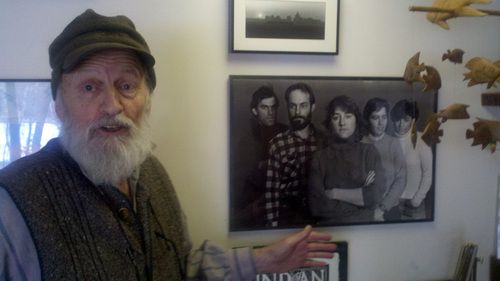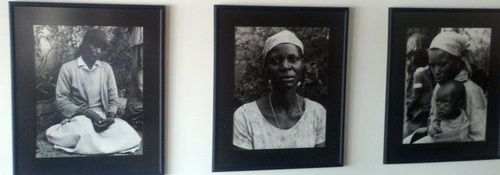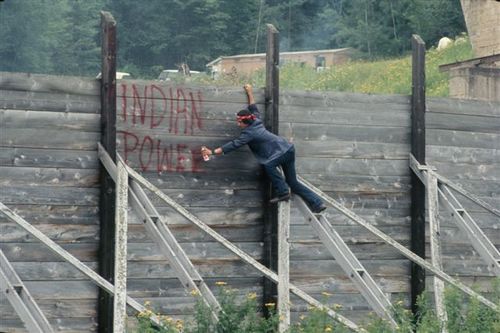I noticed the Star Tribune carried a short article today on Dick Bancroft, who has made a name for himself over the years for photographing members and events of the American Indians Movement. He was one of the subjects of NewsCut “You Should Meet” series in 2012, so it seems like a good time to revisit the entry.
[Originally published February 6, 2012]
If Dick Bancroft hadn’t come down from Saint Paul’s Summit Hill District as a young man, he might never have known the “invisible minority” he champions so fiercely.
Bancroft, of Sunfish Lake, is a self-taught photographer who says his art informs “the washed” about the victims who are left behind. He was nominated for NewsCut’s You Should Meet series, by his daughter, Ann, who wrote:
“He’s a guy who has always opened his home to others. Troubled kids, folks from overseas needing a pillow for a night or a few weeks – whomever. When I was in high school, a medicine man lived with us for a time. Every morning there would be a pile of wood shavings neatly on the living room floor in front of the fireplace where he had carved in preparation for services the next day. My dad is all about community. An old neighborhood guy, he will speak at funerals when no one else dares and he’ll visit you in prison even if he agrees with why you are there. When I heard your piece, I thought of him because he does this not to be noticed or written about. It’s just him. It inspires me every day to try and do the same. ”
Bancroft is the son of an insurance underwriter and might well have lived the life of many old-timers in Saint Paul. “I’m uneducated by international standards,” he told me last week when we visited. “I didn’t make it through the university. I didn’t know what dyslexia was; I didn’t know why I was failing exams. I’m just a punk kid from Saint Paul.”
By the time he joined the Marines in 1945, World War II was about over. His dad, an insurance underwriter for The Saint Paul Companies, convinced him to enter the insurance business. That gave him the first opportunity to understand that there are two worlds.
“In my selling of insurance, I reviewed the insurance programs of two settlement houses: Neighborhood House and Hallie Q. Brown. I ended up being educated by the people who ran those two organizations about what was going on beyond the Hill District,” he said. “Linwood was all white. The black kids lived in the Marshall area. There were no people of color in my classroom. The only exposure to people of color is when we took my father to Union Depot and a Red Cap (porter) would come out. ”
“My last annual salary before I left (insurance) was $10,000 a year, and I was supporting a family of four kids, owned my own home, and had a car,” he said. But by the ’60s, the world was calling him to go in a different direction.
“I was exposed to the life of black people by the people who ran these places and I ended up on the board of Neighborhood House. I got hooked by these people who were dealing with other people who were different,” he said.
“I wanted to go to Selma for the march and these two ministers were trying to get me to go. Debby and I had our third child by then. ‘You can’t leave me here,’ she said. I should have gone. I would have loved to have been a Freedom Rider. That’s where I was part-time in my head, and I was still trying to sell insurance. It was a struggle, then you go home at night and here are these marvelous kids popping out and we have a marvelous family life. The leadership at Halley finally convinced me I’ve got to stop talking and start doing something. They said, ‘you need to live and experience another country.'”
So he did. In 1967, he and his wife and four kids — the oldest was 12, the youngest was four — moved to Kenya to work with the Presbyterian Church. “If they’d been teenagers it wouldn’t have worked. These kids didn’t have that social life yet.”
(Mr. Bancroft’s three favorite pictures occupy a prominent location in his Sunfish Lake home.)
There, they experienced a view of the world — and of the United States — not available to the middle class of Saint Paul. He saw the war in Vietnam from a different angle. He learned more about what it means to be African.
He left the country as a Republican. He returned as a Democrat. But he returned to an unchanged Saint Paul. “(My father) never got over the fact that my boss in Kenya was Negro,” he said. “All he could think of was red caps and Pullman porters. I never could convince him; he was getting old and it was all locked in. That’s the way it is for a lot of people; they’re locked in to their attitudes and experiences in their younger years, and it’s a threat to them to change. That’s their security blanket.”
He wasn’t a photographer by training, but he started showing his pictures from Kenya to people in the Twin Cities. By then, he decided he wanted to become a photographer. He started photographing the peace movement, and started by photographing Minnesotans at a Washington rally for the Saint Paul Dispatch newspaper.
“I gave the editor my pictures and he said, ‘We’ll do a whole page of these,’ and I got $7 apiece for the pictures and I decided right then and there, ‘I can’t make a living doing this,'” Bancroft said.
But the peace movement was well underway and he wanted to be part of it.
Another Direction – Trailer from Reel Nomad on Vimeo. See the film
The times were changing Bancroft and his family. But it wasn’t until 1970 that he found his true calling. He was serving on a United Way subcommittee in Saint Paul when two fledgling organizations — the American Indian Movement and the American Indian Center — submitted funding applications.
“I didn’t know any Indians,” he said. “So I went to see those people. For about a year we struggled to find, out ‘who are these people?’ They were the invisible minority.” Minneapolis has the largest urban Native American population in the country, and yet they were invisible.
The application was approved and Bancroft asked an official of one organization, “How can I help?”
“What do you do?” a woman said.
“I take pictures,” Bancroft said.
“Well, you better start taking pictures.”
That’s how a 40-year association chronicling the lives of American Indians started. “And I became an advocate,” he said.
“Indians have an oral tradition. And writing and photographing was not part of their culture. The oral tradition was when you sat down with an elder and you get the elder to tell you what happened. They were your teachers, but there was nothing written down. So taking pictures of all of this was sort of a modern concept. I was the only one who could afford a camera who was hanging around with these people. I started doing it and I never went back to a desk. The camera took me all over the place.
“In 1972, there was a motor caravan called the Trail of Broken Treaties. It was a protest to Washington. I took my car and headed for DC with four Indians in the car. It took us a week to get there and we occupied a building for 10 days. I photographed it in depth.”
He’s visited Ireland, Nicaragua, Libya, South Africa and dozens of other countries. The theme throughout each one, he said, is the suffering of an indigenous people. “They sparked me to deal with victims in the broadest sense. These are people who are left out and don’t get a chance,” he said.
“None of this would’ve happened to me if it wasn’t for the Indian experience.”
In the 40 years of photographing Native Americans, Bancroft has never sold a picture. “They’re very sensitive to the white man ripping them off,” he said. “I was very fortunate that I did not have to provide for my family monetarily, which gave me a lot of leeway in what I was doing. ”
He’s still photographing, but these days, he says, he’s mentoring young photographers, although he insists they’re mentoring him. “One of my mentors is a Hmong kid, who’s 25 years old, who’s already done a book on photography. He has stimulated me and I call him my mentor because he’s way ahead of me,” Bancroft says.
“Because I’m dyslexic, I can’t remember what I’ve read. I was lousy in school. I just zeroed out. But I learned that I learn by experience and with Jesse (Hardman) and Danny, and many others like them, they’re my teachers because I’m learning from them and they think they’re learning from me.”




